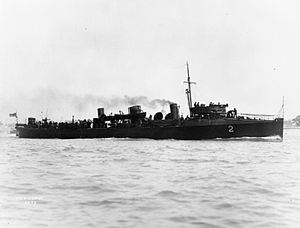HMS Crane (1896)

HMS Crane
|
|
| History | |
|---|---|
|
|
|
| Name: | HMS Crane |
| Ordered: | 1895 – 1896 Naval Estimates |
| Builder: | Palmers, Jarrow |
| Laid down: | 2 August 1896 |
| Launched: | 17 December 1896 |
| Commissioned: | April 1898 |
| Out of service: | Laid up in reserve 1919 |
| Honours and awards: |
Belgian Coast 1914 - 1917 |
| Fate: | Sold for breaking, 10 June 1919 |
| General characteristics | |
| Class and type: | Palmer three-funnel, 30-knot destroyer |
| Displacement: |
|
| Length: | 219 ft 9 in (66.98 m) o/a |
| Beam: | 20 ft 9 in (6.32 m) |
| Draught: | 8 ft 11 in (2.72 m) |
| Installed power: | 6,000 shp (4,500 kW) |
| Propulsion: |
|
| Speed: | 30 kn (56 km/h) |
| Range: |
|
| Complement: | 60 officers and men |
| Armament: |
|
| Service record | |
| Operations: | World War I 1914 - 1918 |
HMS Crane was a Palmer three-funnel, 30-knot destroyer ordered by the Royal Navy under the 1895–1896 Naval Estimates. She was the sixth ship to carry this name since it was introduced in 1590 for a 24-gun schooner in service until 1629.
She was laid down on 2 August 1896 at the Palmer shipyard at Jarrow-on-Tyne and launched on 17 December 1896. During her builder’s trials Crane made her contracted speed requirement. She was completed and accepted by the Royal Navy in April 1898.
After commissioning Crane was assigned to the Devonport Flotilla. In 1902 she deployed to the Mediterranean returning to Home Waters in 1904. On her return to Home Waters she was assigned to the East Coast Flotilla.
On 10 March 1910 Crane was moored to a buoy in Portsmouth harbour when she was rammed by the cross-Channel ferry Princess Margaret. Crane's bows were badly damaged in the collision.
On 30 August 1912 the Admiralty directed all destroyer classes were to be designated by alpha characters starting with the letter 'A'. Since her design speed was 30 knots (56 km/h; 35 mph) and she had three funnels, she was assigned to the C class. After 30 September 1913, she was known as a C-class destroyer and had the letter ‘C’ painted on the hull below the bridge area and on either the fore or aft funnel.
In July 1914 she was in active commission in the 7th Destroyer Flotilla based at Devonport tendered to HMS Leander, destroyer depot ship to the 7th Flotilla. In September 1914 the 7th was redeployed to the Humber River. She remained in this deployment until the cessation of hostilities. Her employment within the Humber Patrol included anti-submarine and counter-mining patrols.
On 28 October 1914 under the command of Commander R. H. Coppinger, she took part in operations off the Belgian Coast.
In 1919 she was paid off and laid-up in reserve awaiting disposal. She was sold on 10 June 1919 to Thos W Ward of Sheffield for breaking at New Holland, Lincolnshire, on the Humber Estuary.
She was awarded the battle honour "Belgian Coast 1914 - 1917".
Note: All tabular data under General Characteristics only from the listed Jane's Fighting Ships volume unless otherwise specified
...
Wikipedia
